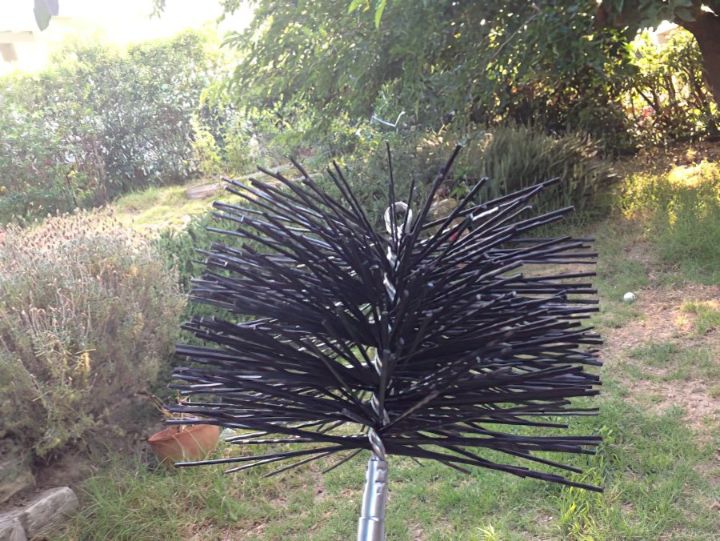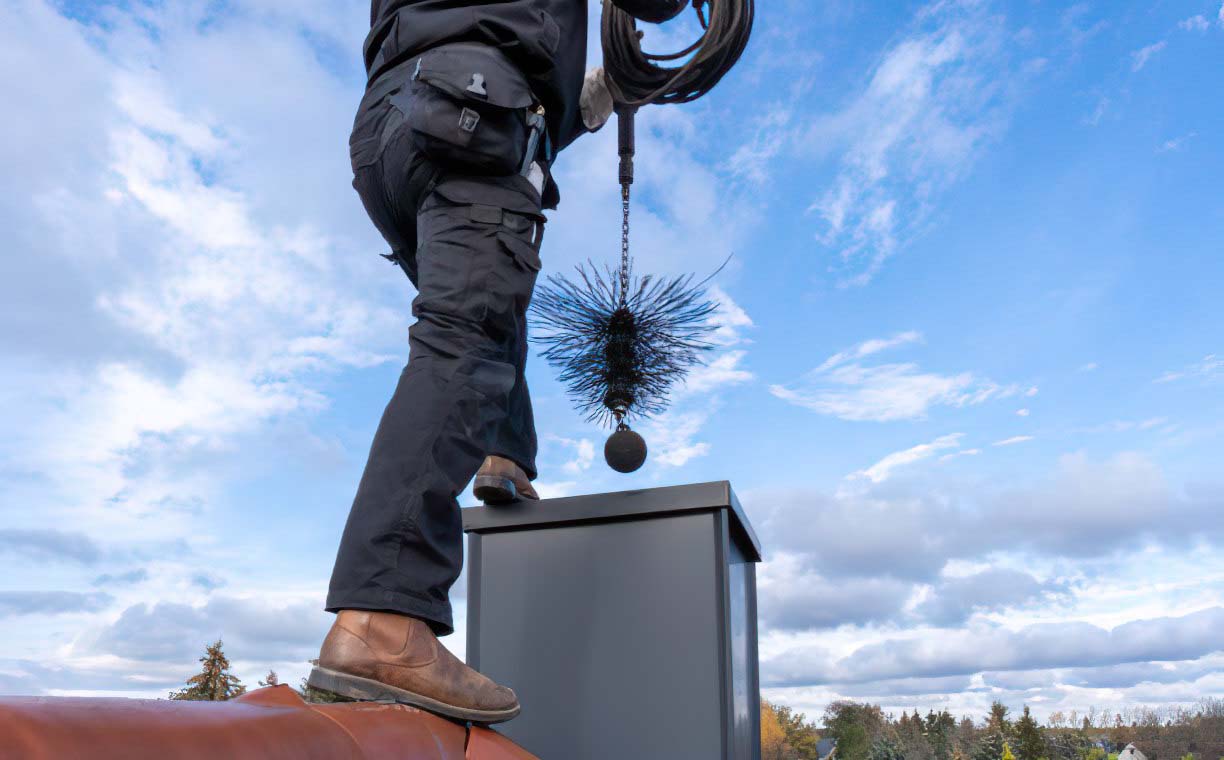So you want to learn how to clean a chimney on your own? A basic chimney cleaning is not that hard to do if you have a few simple tools.
Important Note:
Although learning how to sweep a chimney is not difficult in its basic aspects, be forewarned that some aspects of cleaning a chimney can be dangerous. Please do not attempt to clean your chimney unless you are sure you can do it safely. If there is any doubt in your mind, hire a professional. Some things to keep in mind are that while a basic cleaning, when done regularly, is easy, some aspects of sweeping a chimney can get a bit trickier. For example, very long or complex chimneys with turns can be much more problematic to clean for an inexperienced person. Also, when learning how to clean a chimney for older chimneys that haven’t been cared for well can have other issues including significant creosote build up that may be hard to remove and/or damage to parts of the chimney which may make use of the fireplace dangerous.
If you have any concern about the stability and condition of your chimney, seek professional help for cleaning and repair. In particular, if you have an older chimney and have never had it professionally assessed, I encourage you to have a professional inspect and clean your chimney at least once. Many old chimneys have damage that makes them unsafe and should be repaired or rebuilt. However, if you are confident that your chimney doesn’t need that kind of repair work, then read on to learn how to clean a chimney.
Now, if you still want to learn how to clean a chimney, here are the basic things you’ll need…
How to Clean a Chimney: Equipment You’ll Need
First of all, you’ll need a chimney brush and poles. While you might have the other things you’ll need already, this is one set of equipment that you’ll likely need to buy. Depending on the size of your chimney, a brush and poles will cost you somewhere from about $50 to $100. While that may seem like a big investment, it is actually very much worth it considering that most professional chimney sweeps charge at least $100 for a single cleaning. Considering that you should sweep your chimney once a year if you use it regularly, it will more than pay for itself in no time.

When you learn how to clean a chimnay, when picking out your chimney brush, make sure you get the right size and shape you need. Most chimneys are round or rectangular. Pick the correct shape brush. Also, you’ll need to measure the size of your chimney. This can usually be done most easily by removing the cap at the top of the chimney and measuring the inner diameter of the chimney.
This brings us to another important note: As you might have guessed, the best way to clean your chimney is from the top. This means you’ll also need a tall, stable ladder so that you can get up onto your roof. Depending on your roof, this may be pretty simple or it may be dangerous. Again, be safe! I won’t be held responsible if you break your neck falling off your roof! (Please don’t hurt yourself!)
Back to the brush… So the brush should be the same diameter as your chimney so that it can easily brush build up out of the chimney. If it is is too small, it will be very hard to fully clean the circumference of the chimney and if too large it simply will not fit into your chimney. Different types of brushes are for different uses. Poly brushes are a bit more gentle on the inside of your chimney, avoiding scratching or other damage. They are usually recommended for newer metal or lined chimneys. Also, brushes vary in their stiffness, often labeled as light duty for softer bristles and medium or heavy duty for the harder bristles. Harder bristles makes it easier to remove build up, but also can make it harder to maneuver in your chimney, particular for those that have a slight bend in the chimney.
The poles you choose are important too. First of all, make sure that they are the right size and type to fit the brush you buy. Also, you’ll need enough length to reach all the way down your chimney from the top. Measure the length of your chimney down to the firebox and make sure you get enough pole to reach at least that length, ideally a bit more so that it is easy to hold onto when it is fully inserted. Most poles come in 4 food lengths, or thereabout, and multiple ones can be screwed together to reach your desired length.
In addition to the brush and poles, there are a few other things that will make your job easier and safer when learning to clean a chimney. The soot and creosote in the chimney can be irritating or toxic so rubber gloves, eye protection and a mask or ventilator are all highly recommended to avoid getting eyes or lungs full of ash. Also, a nice thick tarp or drape along with some heavy duty tape is helpful to seal up your fireplace to avoid getting soot all over your house. To be extra safe, you might want to put down some other drop cloths over the furniture in that room. Although, if you seal up the fireplace well enough, none should get out into the room.
Finally, for clean-up you’ll need something to brush up or scoop up the debris that is left in your fireplace after you learn how to sweep a chimney. I like to have a powerful shop vac to easily suck up most of the material, leaving just a bit to sweep up at the end. This tends to be faster and less messy.
How to Clean a Chimney: How to Do It
After gathering your supplies, start by doing a bit of prep work to keep things clean. You will be pushing the ash and creosote build up down the chimney from the top. It can be quite fine particulate matter so it has a tendency to get everywhere inside the house. But with a bit of prep work you can avoid a mess.
What I like to do is to use duct tape or masking tape to tape a plastic trash bag, tarp, plastic drop cloth or fabric across the entire opening of the fireplace inside the house. You should take time to make it as air-tight as possible so that if a draft comes down the chimney it doesn’t blow ash through into the house. This is all the prep that I do inside, but if you are really paranoid or can’t fully cover the chimney opening, you might consider covering your furniture in that room just in case. I’ve never had even a spot of soot come into the room when I sealed the firebox however.

Next, gather your supplies and bring them up to your rooftop next to the chimney. Make sure you have everything you need before you get started so you don’t have to keep running up and down the ladder. Make sure you have gloves, eye and breathing protection, a flashlight, a screwdriver and your chimney brush and poles up there all at your fingertips.
Once you are ready, open the top of your chimney. There are several types of chimneys. Some are open at top but most have some sort of chimney cap that protects from rain, leaves and other things from dropping into the chimney. Most of these can simply be removed, usually with screw or two that needs to be removed to loosen it. Once the cap is off and securely placed down near the chimney, you can start cleaning!
Take an initial look down the chimney, using your flashlight, to inspect. Check to see the condition of the flue and whether there are any barriers, turns or other issues that may complicate your cleaning. Even if you think you know the basics of how to clean a chimney, if you find any damage or otherwise questionable issues, defer to a professional to assess the state of your chimney before continuing.
Next, start cleaning by attaching the brush to the first pole and insert it into the top of the chimney. Gently push the brush down into the chimney, using a twisting movement to gently, but firmly, scrape the brush up and down the length you can reach with the first pole. Be sure to twist the brush as you move it in and out to scrape the sides of the chimney as thoroughly as possible.

Once you have scraped all that you can reach with that pole, push it most of the way in and attach a 2nd pole to the end of the 1st. Then push it down and repeat the scraping process at the lower levels. Continue adding poles and scraping until you get down as far as you can, ideally down to the top of the firebox. If you meet more resistance at any time, pull the brush out and take a look with the flashlight to see if you can identify the problem.
Once you are confident that you have pushed the brush all the way down, you are done! After you re-secure the chimeny cap, all you have left is a bit of clean up.
At this point I like to take a few minutes to let the soot settle inside the fireplace. Don’t pull off that plastic cover just yet or a small gust of air could push a bunch of fine ash into your room! To be totally safe, you can wait about an hour, but in practice I haven’t had a problem opening the fireplace after only about 5 to 10 minutes. You will notice fine ash covering the inside of the fire box. If it is abundant, I like to use a small shovel or other scooper to scoop out the majority of the soot, carefully putting it in a close-able trash bag. You can then finish up by using a shop vac or other high power vacuum to clean out all the nooks and crannies of all the ash, soot and debris you can find.
Once you are close to clean, you may want to look up into the flue from the fire box with a flashlight to see if there is any other caked on soot and creosote down low that the chimney brush couldn’t reach from above. If there is, you can carefully reach up with a hand brush and clean it off. But be careful! If you don’t have a mask and eye protection on you could get a face full of soot as you break it free!
After a final vacuuming out of the fire box, your cleaning job is done! You’ve learned how to clean a chimney!
I hope this is helpful and that some of you can save some money by learning how to clean a chimney and doing it yourself!
Cheers!
Hi, I’m Adam and I’m a HUGE fan of Food and Cooking.
Do you enjoy grilling sessions with your family while staring at the beautiful fire pit flames?
Flame Gorilla is the site to learn how to have that perfect backyard experience.

